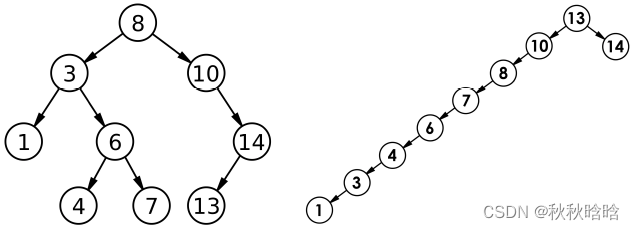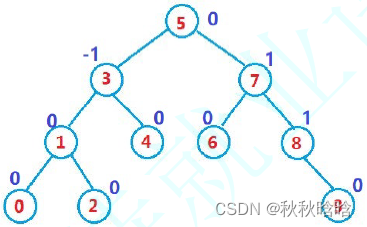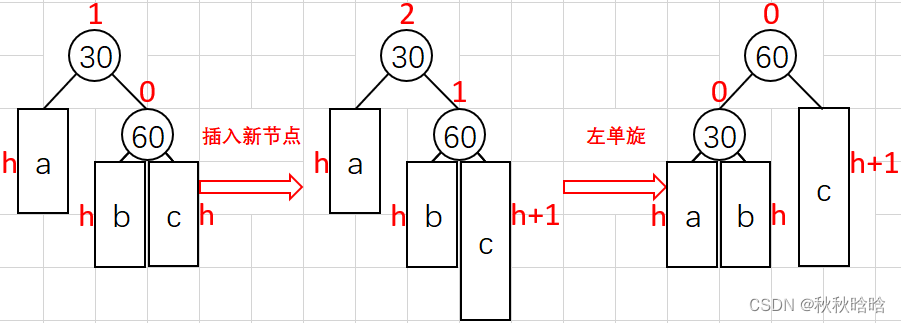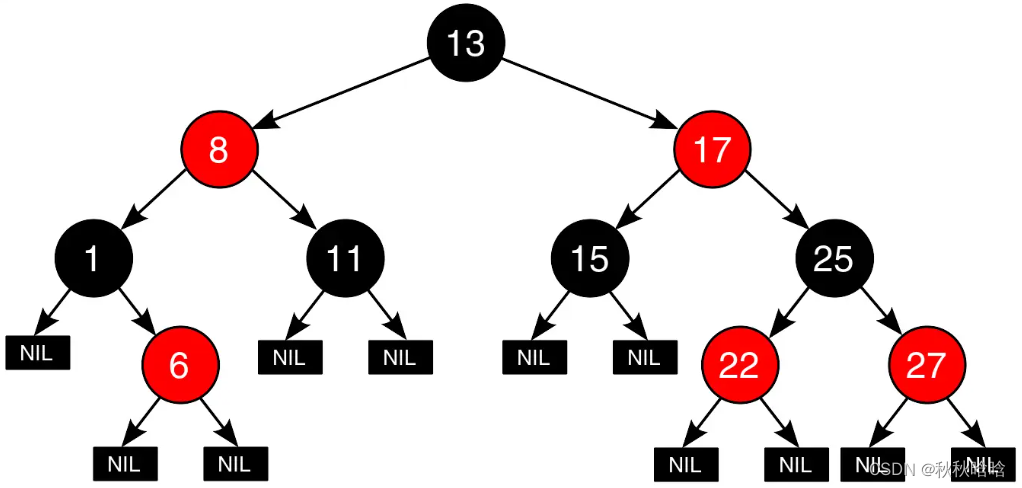目录
1. 二叉搜索树
1.1 二叉搜索树的概念
二叉搜索树(BST, Binary Search Tree)又称二叉查找树、二叉排序树,它或者是一棵空树,或者是具有以下性质的二叉树:
- 若左子树非空,则左子树上所有结点的值都小于根结点的值
- 若右子树非空,则右子树上所有结点的值都大于根结点的值
- 它的左右子树也分别为二叉搜索树
根据二叉排序树的定义,左子树结点值 < 根结点值 < 右子树结点值,因此对二叉排序树进行中序遍历,可以得到一个递增的有序序列。
1.2 二叉搜索树类模板
// 二叉搜索树结点
template<class K>
struct BSTreeNode
{
BSTreeNode<K>* _left;
BSTreeNode<K>* _right;
K _key;
BSTreeNode(const K& key)
: _left(nullptr)
, _right(nullptr)
, _key(key)
{}
};
// 二叉搜索树
template<class K>
class BSTree
{
typedef BSTreeNode<K> Node;
public:
// 查找
bool Find(const K& key)
{
// ……
}
// 插入
bool Insert(const K& key)
{
// ……
}
// 删除
bool Erase(const K& key)
{
// ……
}
private:
Node* _root = nullptr;
};1.3 二叉搜索树的操作
1.3.1 查找
- 从根开始比较,查找,比根大则往右边走查找,比根小则往左边走查找
- 最多查找高度次,走到到空,还没找到,这个值不存在
bool Find(const K& key)
{
Node* cur = _root;
while (cur)
{
if (cur->_key < key)
{
cur = cur->_right;
}
else if (cur->_key > key)
{
cur = cur->_left;
}
else
{
return true;
}
}
return false;
}1.3.2 插入
- 树为空,则直接新增结点,赋值给root指针
- 树不空,按二叉搜索树性质查找插入位置,插入新结点
bool Insert(const K& key)
{
if (_root == nullptr)
{
_root = new Node(key);
return true;
}
Node* parent = nullptr;
Node* cur = _root;
while (cur)
{
if (cur->_key < key)
{
parent = cur;
cur = cur->_right;
}
else if (cur->_key > key)
{
parent = cur;
cur = cur->_left;
}
else
{
return false;
}
}
cur = new Node(key);
// 链接
if (parent->_key < key)
{
parent->_right = cur;
}
else
{
parent->_left = cur;
}
return true;
}1.3.3 删除
首先查找元素是否在二叉搜索树中,如果不存在,则返回; 否则要删除的结点可能分下面四种情况:
- 要删除的结点是叶子结点——直接删除
- 要删除的结点没有右孩子——令Node的子树成为Node双亲结点的子树,替代Node的位置
- 要删除的结点没有左孩子——令Node的子树成为Node双亲结点的子树,替代Node的位置
- 要删除的结点有左、右孩子——令Node的直接后继(或直接前驱)替代Node,然后从二叉搜索树中删除这个直接后继(或直接前驱),这样就转换成了情况2或情况3。
Node的直接后继:在中序遍历下,Node的后一个结点。在二叉搜索树中,Node的直接后继就是在它的右子树中关键码最小的结点。
Node的直接前驱:在中序遍历下,Node的前一个结点。在二叉搜索树中,Node的直接前驱就是在它的左子树中关键码最大的结点。
实际情况1可以与情况2或者3合并起来,删除结点就分为3种情况。

bool Erase(const K& key)
{
Node* parent = nullptr;
Node* cur = _root;
while (cur)
{
if (cur->_key < key)
{
parent = cur;
cur = cur->_right;
}
else if (cur->_key > key)
{
parent = cur;
cur = cur->_left;
}
else
{
// 1、左为空
if (cur->_left == nullptr)
{
if (cur == _root)
{
_root = cur->_right;
}
else
{
if (parent->_left == cur)
{
parent->_left = cur->_right;
}
else
{
parent->_right = cur->_right;
}
}
delete cur;
}
// 2、右为空
else if (cur->_right == nullptr)
{
if (cur == _root)
{
_root = cur->_left;
}
else
{
if (parent->_left == cur)
{
parent->_left = cur->_left;
}
else
{
parent->_right = cur->_left;
}
}
delete cur;
}
// 3、左、右都不为空
else
{
// 找右子树最小结点替代,也可以是左树最大结点替代
Node* pminRight = cur;
Node* minRight = cur->_right;
while (minRight->_left)
{
pminRight = minRight;
minRight = minRight->_left;
}
cur->_key = minRight->_key;
if (pminRight->_left == minRight)
{
pminRight->_left = minRight->_right;
}
else
{
pminRight->_right = minRight->_right;
}
delete minRight;
}
return true;
}
}
return false;
}1.4 二叉搜索树的性能分析
插入和删除操作都必须先查找,查找效率代表了二叉搜索树中各个操作的性能,查找效率,主要取决于树的高度。
对于同一个关键码集合,如果各关键码插入的次序不同,可能得到不同结构的二叉搜索树:

最好情况下,二叉搜索树的左、右子树的高度之差的绝对值不超过1(平衡二叉树),时间复杂度为O(logn)。
最坏情况下,二叉搜索树是一个只有右(左)孩子的单支树(类似于有序的单链表),时间复杂度为O(n)。
2. 平衡二叉树
2.1 平衡二叉树的概念
二叉搜索树虽可以缩短查找的效率,但如果数据有序或接近有序二叉搜索树将退化为单支树,查找元素相当于在顺序表中搜索元素,效率低下。因此,两位俄罗斯的数学家G.M.Adelson-Velskii和E.M.Landis在1962年发明了一种解决上述问题的方法:当向二叉搜索树中插入新结点后,如果能保证每个结点的左右子树高度之差的绝对值不超过1(需要对树中的结点进行调整),即可降低树的高度,从而减少平均搜索长度。
一棵AVL树或者是空树,或者是具有以下性质的二叉搜索树:
- 它的左右子树都是AVL树
- 左右子树高度之差(简称平衡因子)的绝对值不超过1(-1/0/1)

2.2 平衡二叉树类模板
// AVL树结点
template<class K, class V>
struct AVLTreeNode
{
AVLTreeNode<K, V>* _left;
AVLTreeNode<K, V>* _right;
AVLTreeNode<K, V>* _parent;
pair<K, V> _kv;
int _bf; // balance factor
AVLTreeNode(const pair<K, V>& kv)
: _left(nullptr)
, _right(nullptr)
, _parent(nullptr)
, _kv(kv)
, _bf(0)
{}
};
// AVL树
template<class K, class V>
class AVLTree
{
typedef AVLTreeNode<K, V> Node;
public:
// 插入
bool Insert(const pair<K, V>& kv)
{
// ……
}
// 中序遍历
void InOrder()
{
_InOrder(_root);
cout << endl;
}
// 是否平衡
bool IsBalance()
{
return _IsBalance(_root);
}
// 高度
int Height()
{
return _Height(_root);
}
private:
// 高度
int _Height(Node* root)
{
if (root == NULL)
return 0;
int leftH = _Height(root->_left);
int rightH = _Height(root->_right);
return leftH > rightH ? leftH + 1 : rightH + 1;
}
// 是否平衡
bool _IsBalance(Node* root)
{
if (root == NULL)
{
return true;
}
int leftH = _Height(root->_left);
int rightH = _Height(root->_right);
if (rightH - leftH != root->_bf)
{
cout << root->_kv.first << "结点平衡因子异常" << endl;
return false;
}
return abs(leftH - rightH) < 2
&& _IsBalance(root->_left)
&& _IsBalance(root->_right);
}
// 左单旋转
void RotateL(Node* parent)
{
// ……
}
// 右单旋转
void RotateR(Node* parent)
{
// ……
}
// 左右双旋转
void RotateLR(Node* parent)
{
// ……
}
// 右左双旋转
void RotateRL(Node* parent)
{
// ……
}
// 中序遍历
void _InOrder(Node* root)
{
if (root == nullptr)
{
return;
}
_InOrder(root->_left);
cout << root->_kv.first << " ";
_InOrder(root->_right);
}
// 成员变量
Node* _root = nullptr;
};2.3 二叉搜索树的插入
AVL树就是在二叉搜索树的基础上引入了平衡因子,因此AVL树也可以看成是二叉搜索树。那么AVL树的插入过程可以分为两步:
- 按照二叉搜索树的方式插入新结点
- 调整结点的平衡因子
如果在一棵原本是平衡的AVL树中插入一个新结点,可能造成不平衡,此时必须调整树的结构,使之平衡化。根据结点插入位置的不同,AVL树的旋转分为四种:
1. 新结点插入较高左子树的左侧——左左:右单旋

上图在插入前,AVL树是平衡的,新结点插入到30的左子树(注意:此处不是左孩子)中,30左子树增加了一层,导致以60为根的二叉树不平衡,要让60平衡,只能将60左子树的高度减少一层,右子树增加一层,即将左子树往上提,这样60转下来,因为60比30大,只能将其放在30的右子树,而如果30有右子树,右子树根的值一定大于30,小于60,只能将其放在60的左子树,旋转完成后,更新结点的平衡因子即可。在旋转过程中,有以下几种情况需要考虑:
- 30结点的右孩子可能存在,也可能不存在
- 60可能是根结点,也可能是子树(如果是根结点,旋转完成后,要更新根结点;如果是子树,可能是某个结点的左子树,也可能是右子树)
void RotateR(Node* parent)
{
Node* subL = parent->_left;
Node* subLR = subL->_right;
parent->_left = subLR;
if (subLR)
subLR->_parent = parent;
Node* ppnode = parent->_parent;
subL->_right = parent;
parent->_parent = subL;
if (parent == _root)
{
_root = subL;
_root->_parent = nullptr;
}
else
{
if (ppnode->_left == parent)
{
ppnode->_left = subL;
}
else
{
ppnode->_right = subL;
}
subL->_parent = ppnode;
}
subL->_bf = parent->_bf = 0;
}2. 新结点插入较高右子树的右侧——右右:左单旋

void RotateL(Node* parent)
{
Node* subR = parent->_right;
Node* subRL = subR->_left;
parent->_right = subRL;
if (subRL)
subRL->_parent = parent;
Node* ppnode = parent->_parent;
subR->_left = parent;
parent->_parent = subR;
if (ppnode == nullptr)
{
_root = subR;
_root->_parent = nullptr;
}
else
{
if (ppnode->_left == parent)
{
ppnode->_left = subR;
}
else
{
ppnode->_right = subR;
}
subR->_parent = ppnode;
}
parent->_bf = subR->_bf = 0;
}3. 新结点插入较高左子树的右侧——左右:先左单旋再右单旋

先对30进行左单旋,然后再对90进行右单旋。
新结点究竟是插入b还是插入c还是60本身就是新结点,不影响旋转过程。
void RotateLR(Node* parent)
{
Node* subL = parent->_left;
Node* subLR = subL->_right;
int bf = subLR->_bf;
RotateL(parent->_left);
RotateR(parent);
if (bf == 1)
{
parent->_bf = 0;
subLR->_bf = 0;
subL->_bf = -1;
}
else if (bf == -1)
{
parent->_bf = 1;
subLR->_bf = 0;
subL->_bf = 0;
}
else if (bf == 0)
{
parent->_bf = 0;
subLR->_bf = 0;
subL->_bf = 0;
}
else
{
assert(false);
}
}4. 新结点插入较高右子树的左侧——右左:先右单旋再左单旋

void RotateRL(Node* parent)
{
Node* subR = parent->_right;
Node* subRL = subR->_left;
int bf = subRL->_bf;
RotateR(parent->_right);
RotateL(parent);
if (bf == 1)
{
subR->_bf = 0;
parent->_bf = -1;
subRL->_bf = 0;
}
else if (bf == -1)
{
subR->_bf = 1;
parent->_bf = 0;
subRL->_bf = 0;
}
else if (bf == 0)
{
subR->_bf = 0;
parent->_bf = 0;
subRL->_bf = 0;
}
else
{
assert(false);
}
}总结:
假如以parent为根的子树不平衡,即parent的平衡因子为2或者-2,分以下情况考虑:
1. parent的平衡因子为2,说明parent的右子树高,设parent的右子树的根为subR:
当subR的平衡因子为1时,执行左单旋;
当subR的平衡因子为-1时,执行右左双旋。
2. parent的平衡因子为-2,说明parent的左子树高,设parent的左子树的根为subL:
当subL的平衡因子为-1时,执行右单旋;
当subL的平衡因子为1时,执行左右双旋。
旋转完成后,原parent为根的子树个高度降低,已经平衡,不需要再向上更新。
bool Insert(const pair<K, V>& kv)
{
if (_root == nullptr)
{
_root = new Node(kv);
return true;
}
Node* parent = nullptr;
Node* cur = _root;
while (cur)
{
if (cur->_kv.first < kv.first)
{
parent = cur;
cur = cur->_right;
}
else if (cur->_kv.first > kv.first)
{
parent = cur;
cur = cur->_left;
}
else
{
return false;
}
}
cur = new Node(kv);
if (parent->_kv.first > kv.first)
{
parent->_left = cur;
}
else
{
parent->_right = cur;
}
cur->_parent = parent;
// 更新平衡因子
while (parent)
{
if (cur == parent->_right)
{
parent->_bf++;
}
else
{
parent->_bf--;
}
if (parent->_bf == 1 || parent->_bf == -1)
{
// 继续更新
parent = parent->_parent;
cur = cur->_parent;
}
else if (parent->_bf == 0)
{
break;
}
else if (parent->_bf == 2 || parent->_bf == -2)
{
// 需要旋转处理 -- 1、让这颗子树平衡 2、降低这颗子树的高度
if (parent->_bf == 2 && cur->_bf == 1)
{
RotateL(parent);
}
else if (parent->_bf == -2 && cur->_bf == -1)
{
RotateR(parent);
}
else if (parent->_bf == -2 && cur->_bf == 1)
{
RotateLR(parent);
}
else if (parent->_bf == 2 && cur->_bf == -1)
{
RotateRL(parent);
}
else
{
assert(false);
}
break;
}
else
{
assert(false);
}
}
return true;
}3. 红黑树
3.1 红黑树的概念
红黑树,是一种二叉搜索树,但在每个结点上增加一个存储位表示结点的颜色,可以是Red或Black。 通过对任何一条从根到叶子的路径上各个结点着色方式的限制,红黑树确保没有一条路径会比其他路径长出俩倍,因而是接近平衡的。
红黑树有如下性质:
- 每个结点不是红色就是黑色
- 根结点是黑色的
- 如果一个结点是红色的,则它的两个孩子结点是黑色的(不存在两个相邻的红结点)
- 对于每个结点,从该结点到其所有后代叶结点的简单路径上,均包含相同数目的黑色结点
- 每个叶子结点都是黑色的(此处的叶子结点指的是空结点)

3.2 红黑树类模板
enum Colour
{
RED,
BLACK,
};
template<class T>
struct RBTreeNode
{
RBTreeNode<T>* _left;
RBTreeNode<T>* _right;
RBTreeNode<T>* _parent;
T _data;
Colour _col;
RBTreeNode(const T& data)
: _left(nullptr)
, _right(nullptr)
, _parent(nullptr)
, _data(data)
, _col(RED)
{}
};
template<class T, class Ref, class Ptr>
struct __RBTreeIterator
{
typedef RBTreeNode<T> Node;
typedef __RBTreeIterator<T, Ref, Ptr> Self;
Node* _node;
__RBTreeIterator(Node* node)
: _node(node)
{}
Ref operator*()
{
return _node->_data;
}
Ptr operator->()
{
return &_node->_data;
}
bool operator!=(const Self& s)
{
return _node != s._node;
}
Self& operator++()
{
if (_node->_right)
{
// 1、右不为空,下一个就是右子树的最左节点
Node* subLeft = _node->_right;
while (subLeft->_left)
{
subLeft = subLeft->_left;
}
_node = subLeft;
}
return *this;
}
};
// 仿函数
template<class K, class T, class KeyOfT>
class RBTree
{
typedef RBTreeNode<T> Node;
public:
~RBTree()
{
_Destroy(_root);
_root = nullptr;
}
public:
typedef __RBTreeIterator<T, T&, T*> itertaor;
typedef __RBTreeIterator<T, const T&, const T*> const_itertaor;
itertaor begin()
{
Node* cur = _root;
while (cur && cur->_left)
{
cur = cur->_left;
}
return itertaor(cur);
}
itertaor end()
{
return itertaor(nullptr);
}
Node* Find(const K& key)
{
Node* cur = _root;
KeyOfT kot;
while (cur)
{
if (kot(cur->_data) < key)
{
cur = cur->_right;
}
else if (kot(cur->_data) > key)
{
cur = cur->_left;
}
else
{
return cur;
}
}
return nullptr;
}
bool Insert(const T& data)
{
if (_root == nullptr)
{
_root = new Node(data);
_root->_col = BLACK;
return true;
}
KeyOfT kot;
Node* parent = nullptr;
Node* cur = _root;
while (cur)
{
if (kot(cur->_data) < kot(data))
{
parent = cur;
cur = cur->_right;
}
else if (kot(cur->_data) > kot(data))
{
parent = cur;
cur = cur->_left;
}
else
{
return false;
}
}
cur = new Node(data);
if (kot(parent->_data) > kot(data))
{
parent->_left = cur;
}
else
{
parent->_right = cur;
}
cur->_parent = parent;
while (parent && parent->_col == RED)
{
Node* grandfather = parent->_parent;
if (grandfather->_left == parent)
{
Node* uncle = grandfather->_right;
// 情况1:u存在且为红,变色处理,并继续往上处理
if (uncle && uncle->_col == RED)
{
parent->_col = BLACK;
uncle->_col = BLACK;
grandfather->_col = RED;
// 继续往上调整
cur = grandfather;
parent = cur->_parent;
}
else // 情况2+3:u不存在/u存在且为黑,旋转+变色
{
// g
// p u
// c
if (cur == parent->_left)
{
RotateR(grandfather);
parent->_col = BLACK;
grandfather->_col = RED;
}
else
{
// g
// p u
// c
RotateL(parent);
RotateR(grandfather);
cur->_col = BLACK;
//parent->_col = RED;
grandfather->_col = RED;
}
break;
}
}
else // (grandfather->_right == parent)
{
// g
// u p
// c
Node* uncle = grandfather->_left;
// 情况1:u存在且为红,变色处理,并继续往上处理
if (uncle && uncle->_col == RED)
{
parent->_col = BLACK;
uncle->_col = BLACK;
grandfather->_col = RED;
// 继续往上调整
cur = grandfather;
parent = cur->_parent;
}
else // 情况2+3:u不存在/u存在且为黑,旋转+变色
{
// g
// u p
// c
if (cur == parent->_right)
{
RotateL(grandfather);
grandfather->_col = RED;
parent->_col = BLACK;
}
else
{
// g
// u p
// c
RotateR(parent);
RotateL(grandfather);
cur->_col = BLACK;
grandfather->_col = RED;
}
break;
}
}
}
_root->_col = BLACK;
return true;
}
bool IsBalance()
{
if (_root && _root->_col == RED)
{
cout << "根节点颜色是红色" << endl;
return false;
}
int benchmark = 0;
Node* cur = _root;
while (cur)
{
if (cur->_col == BLACK)
++benchmark;
cur = cur->_left;
}
// 连续红色节点
return _Check(_root, 0, benchmark);
}
int Height()
{
return _Height(_root);
}
private:
void _Destroy(Node* root)
{
if (root == nullptr)
{
return;
}
_Destroy(root->_left);
_Destroy(root->_right);
delete root;
}
int _Height(Node* root)
{
if (root == NULL)
return 0;
int leftH = _Height(root->_left);
int rightH = _Height(root->_right);
return leftH > rightH ? leftH + 1 : rightH + 1;
}
bool _Check(Node* root, int blackNum, int benchmark)
{
if (root == nullptr)
{
if (benchmark != blackNum)
{
cout << "某条路径黑色节点的数量不相等" << endl;
return false;
}
return true;
}
if (root->_col == BLACK)
{
++blackNum;
}
if (root->_col == RED
&& root->_parent
&& root->_parent->_col == RED)
{
cout << "存在连续的红色节点" << endl;
return false;
}
return _Check(root->_left, blackNum, benchmark)
&& _Check(root->_right, blackNum, benchmark);
}
void RotateL(Node* parent)
{
Node* subR = parent->_right;
Node* subRL = subR->_left;
parent->_right = subRL;
if (subRL)
subRL->_parent = parent;
Node* ppnode = parent->_parent;
subR->_left = parent;
parent->_parent = subR;
if (ppnode == nullptr)
{
_root = subR;
_root->_parent = nullptr;
}
else
{
if (ppnode->_left == parent)
{
ppnode->_left = subR;
}
else
{
ppnode->_right = subR;
}
subR->_parent = ppnode;
}
}
void RotateR(Node* parent)
{
Node* subL = parent->_left;
Node* subLR = subL->_right;
parent->_left = subLR;
if (subLR)
subLR->_parent = parent;
Node* ppnode = parent->_parent;
subL->_right = parent;
parent->_parent = subL;
if (parent == _root)
{
_root = subL;
_root->_parent = nullptr;
}
else
{
if (ppnode->_left == parent)
{
ppnode->_left = subL;
}
else
{
ppnode->_right = subL;
}
subL->_parent = ppnode;
}
}
private:
Node* _root = nullptr;
};





















 2162
2162











 被折叠的 条评论
为什么被折叠?
被折叠的 条评论
为什么被折叠?








